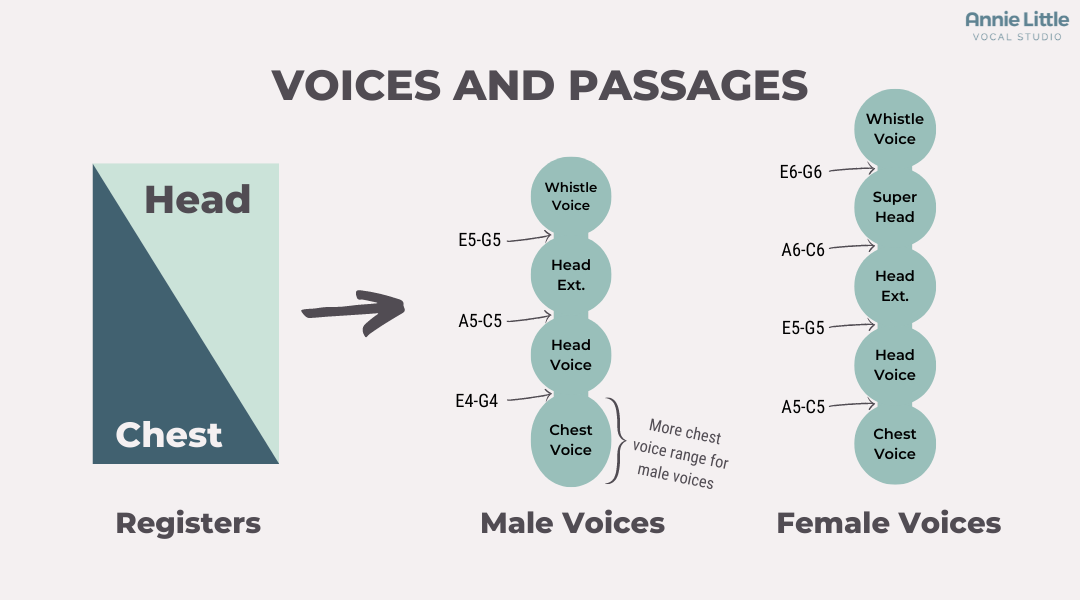Vocal Registers Explained Simply
THIS BLOG HAS BEEN MOVED TO OUR NEW WEBSITE. GO READ IT HERE.
Vocal Registration is like driving a stick-shift car: you don’t need to know exactly how the transmission works to know how to use the clutch and shift gears while you’re driving!
Let’s clarify what vocal registration is, the difference between registers and voices, and what passages are.
What are Vocal Registers?
I think of vocal registers like the gears of a car. Those gears are mechanisms that each produce a series of similar sounds, and the sounds of each gear differ from the other. Chest and head registers are the two gears of the voice.
These registers have the ability to combine, or blend, to form a series of interconnected voices and passages.
The act of combining or blending these registers, even imperfectly, is the act of vocal registration.
The chest and head registers are the two different mechanisms that control pitch and registration. They are basically the two different sets of muscles, or mechanisms, that allow you to sing from the bottom to the top of your range smoothly and with different intensities.
More on Chest and Head Registers
Let's start with the chest register which is primarily controlled by the TA (thyroarytenoid) muscles inside the vocal folds. These muscles thicken and shorten the vocal folds, producing sympathetic vibrations in the chest. The sounds produced by this mechanism are associated with our speaking voice and the lower part of our range and are naturally louder and more vibrant. Chest voice is produced by the chest register.
Then we have the head register that is primarily controlled by the CT (cricothyroid) muscles. These muscles are outside the vocal folds, and they stretch and thin the vocal folds, allowing them to go higher in pitch. The sounds produced by the head register create sympathetic vibrations in the head, are naturally softer and sweeter, and are associated with the higher part of our range. Head voice is produced by the head register.
When these two registers are connected and well-coordinated, it might feel and sound like you have one voice, instead of that feeling of flipping feeling between our speaking voice, and our higher voice! This happens when we are able to sing in a mix or mixed voice. In other words, we are blending the registers.
Voices and Passages
It’s hard to talk about voices without bringing up the passages in between them. Let’s first start with voices.
What do we mean when we talk about “voices” like chest voice or head voice?
If registers are mechanisms, you can think of voices as the coordinations produced by those registers.¹ In other words, chest voice is a coordination produced by the chest register.
When the registers are blending they produce voices that are interconnected from the bottom to the top of the range. Those voices are connected by passages.
Within each "voice" the voice feels and sounds more similar and feels more stable than the areas between each of the "voices" which are called passages.
These passages are also known as the passagio, bridge, or transition. Some singers even call these areas of instability their "break".
This inherent instability is the result of laryngeal and/or acoustic events. In other words, the chest register muscles need to “hand over” control to the head register muscles as we move up in pitch.
We also need to adjust our resonance with the shape of the vocal tract to help us smoothly navigate through those passages.
These passages get easier to navigate with training and experience. This is why learning to mix is a crucial part of learning to sing well. We use vocal registration to be able to blend the registers and use a mixed voice.
So, while you certainly don’t need to be a voice scientist to learn to sing well, it can help a lot to understand some of the basics of how the voice works.
I hope this has clarified some terminology for you! Please comment with any questions. Or, feel free to DM me on Instagram. I love to hear from you!
¹ Institute for Vocal Advancement course study. https://www.vocaladvancement.com/


